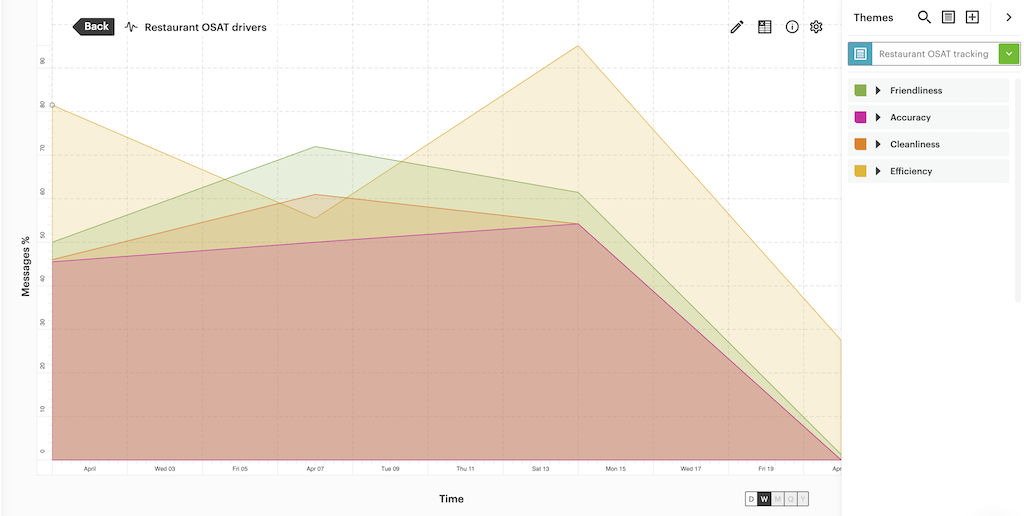Getting into the nuances of restaurant guest feedback

Analyzing nuanced feedback from restaurant guests is a delicate balancing act between time, detail and relevance.
The best-performing restaurants act on feedback from diners quickly and decisively. This requires accurate intelligence that will have a tangible impact on guest experience, delivered quickly.
Trying to satisfy these three elements is easier said than done. For example, manually analyzing feedback should pinpoint changes that make a difference. However, this type of analysis takes considerable amounts of time if insights teams are manually reading and coding large numbers of responses, plus could be impacted by human bias.
Similarly, a word cloud will quickly surface the most common words used in feedback. What it doesn’t do is provide rigorous intelligence that will persuade your stakeholders to act.
This is why numerous quick service restaurants and casual dining brands use Relative Insight to analyze guest feedback. Our platform offers auditable, actionable intelligence at speed.
To demonstrate how this works in practice, here is how a renowned US casual dining chain acted on feedback in one of its Midwestern locations.
Visualizing its four key challenges
The brand conducts a standardized post-visit overall satisfaction (OSAT) surveys. It segments feedback between promoters and detractors — with a lazer focus on the latter.
When analyzing detractor feedback, the chain’s insights team is focused on four areas: efficiency, accuracy, cleanliness and staff friendliness. The brand has identified these as drivers of overall satisfaction; if a location stays on top of them, customers are happy.
As the team knows exactly what it wants to look for in detractor feedback, it has built Custom Themes to capture these conversations. Using Relative Insight’s Heartbeat tool, it visualizes how prevalent these themes are within detractor feedback.
Below is the Heartbeat chart for one of its outlets in the Midwest over the course of April 2024. You’ll see that detractor comments focused on these four themes. This negative focus on its four key elements was accompanied by a fall in the store’s OSAT score.


By digging into this data using Relative Insight Explore, the brand identified nuances within these comments, enabling its managers to act. What follows is this store’s journey across April, as it remedied challenges based on guest feedback.
Issues headlined by slow service
At the beginning of April, all four of the drivers of guest satisfaction were prominent within guest feedback. However, the issue of efficiency was the most prominent within customers’ complaints.
Using Explore to dig into these complaints highlighted that the wait time between customers ordering and being served was far too long. The phrase ‘long wait’ appeared 5.6x more in detractor responses.
“We had to wait an unreasonable amount of time for our food!“
This wait was caused by a breakdown between food being ready and being served. Therefore, not only were customers waiting too long, their food arrived cold too. Respondents complained about ‘cold’ food infinitely more in this week’s responses.
“Despite waiting for nearly an hour, our meal was cold when it arrived. It ruined our evening.“
As well as fixing the operational issue between kitchen and waiting staff, restaurant management also placed an emphasis on efficiency following this feedback.
Guest experience gets worse
Fixing guest experience is often an iterative process, rather than linear. So it proved here, with the restaurant’s OSAT score falling again, despite attempts to fix the previous week’s problem.
As the Heartbeat chart illustrates, while complaints around efficiency fell after the restaurant implemented changes, negative customer feedback around cleanliness and friendliness spiked.
Drilling down into the reasons for this showed prioritizing efficiency had led to staff cutting corners elsewhere. When it came to cleanliness, guests were 4.3x more likely to describe the restaurant as ‘unclean’ compared to the previous week, as well as describing it as ‘filthy’ 2.4x more.
“The restaurant looked like it hadn’t been cleaned in a while. The tables and floors were filthy.“
Guests were also unhappy with how staff treated them. They were infinitely more likely to talk about staff being ‘dismissive’, or their queries being ‘ignored’. However, diners’ feedback also revealed the reason for this: they used words relating to ‘speed’ 4.8x more, including ‘rushing’ and ‘hurried’.
“The staff were so busy rushing around that they didn’t have time to check on us or address our needs.“
In trying to ensure the restaurant was running efficiently, staff had created a worse experience for guests.
Efficiency becomes a problem again
Faced with further falls its OSAT score, restaurant managers revamped key processes in the outlet. As this new system bedded in, staff were encouraged to focus on accuracy, cleanliness and friendliness.
The Heartbeat chart demonstrates that staff got a handle on these three elements, but it was once again at the cost of efficiency. On this occasion, there was a different reason for the rise in complaints around efficiency; highlighting the importance of pinpointing the nuances in discussions.
Customers were 6.4x more likely to talk about ‘long wait’ time, however, this related to getting into the restaurant, rather than for food. They highlighted waiting despite having a ‘reservation’ infinitely more, while also discussing their discomfort in having to wait at the front of the restaurant.
“We had to wait an excessively long time for a table, and the waiting area was very uncomfortable.“
While not ideal, restaurant management knew that its focus on ensuring cleanliness, accuracy and friendliness could initially impact efficiency. Its strategy was vindicated, with a rise in the restaurant’s OSAT score and fall in the number of detractors. Once guests were seated, they had an enjoyable experience.
Mastering OSAT score drivers through nuanced text analysis
The new process bore fruit the following week. Detractor comments around efficiency, accuracy, friendliness and cleanliness fell sharply, as did the number of detractors overall.
After taking a week to adjust to the new system, staff were able to seat guests much more quickly, leading to a big drop in complaints around wait times. This was also reflected in the outlet’s OSAT score, which rose sharply week on week.
Do you broadly understand what your guests are talking about, but need nuanced analysis to take the right action? Speak to one of Relative Insight’s experts to see how our software can help you identify why your OSAT score is rising, falling or remaining stable.
